 Election officials in St. Louis County, Missouri were repeatedly warned by local Election Integrity advocates that a plan to supply enough paper ballots for only 15% of the electorate at polling places on Election Day there would not be enough, according to emails obtained by The BRAD BLOG.
Election officials in St. Louis County, Missouri were repeatedly warned by local Election Integrity advocates that a plan to supply enough paper ballots for only 15% of the electorate at polling places on Election Day there would not be enough, according to emails obtained by The BRAD BLOG.
The emails, sent well before Election Day, expressed concern and doubt about "enough paper ballots at every polling place on November 4th to cover all of the voters who would like to have one," as one of advocates wrote to the Democratic Director of Elections in St. Louis County.
The warnings were ignored, the missives suggest, and, as reported by local media, the result was a widespread shortage of paper ballots on Election Day 2014 at sites throughout the county, including in the embattled city of Ferguson, MO. Throughout the county, the shortage of ballots resulted in long lines and voters who were turned away or forced to vote on 100% unverifiable touch-screen systems which the county has long encouraged voters to use. Some precincts were required to stay open at least an hour after the normal closing time in order to accommodate those who were in line to vote before the close of polls at 7pm local time.
St. Louis Public Radio reported the day after the election that "unexpected demand for paper ballots caused a shortage at about 95 polling places throughout the county Tuesday. That's more than 20 percent of the county's 444 balloting sites."
"The paper shortage," they explained, "was the biggest unexpected problem on Election Day."
But, in truth, it wasn't unexpected at all, at least according to emails we reviewed to and from the county's chief election official, suggesting that the Board of Elections simply ignored the clear warnings they had received from local Election Integrity experts...
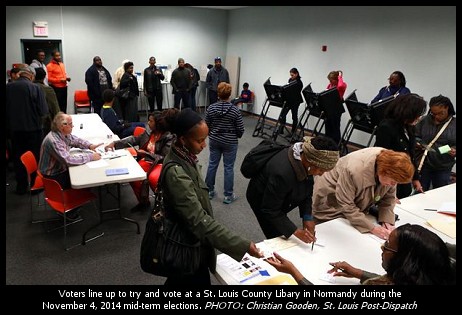
Long lines, voters turned away, polls forced to stay open
On Election Night, we were first tipped off to the shortage of ballots in Ferguson, where officials might have expected an increased turnout this year, by a longtime reader who reported his own precinct in the town "ran out of paper ballots at 4:20 this afternoon and had hours long lines for 3 electronic voting machines."
The voter, Cary Aye, had refused to vote on the electronic touch-screen systems that the county offers alongside their hand-marked paper ballot system, even while officials in the county have long encouraged the use of the unverifiable ES&S iVotronic touch-screen systems. Aye was ultimately allowed to cast his vote on a paper ballot and told us that "there were 5 other people in the last of the line when at 8:10, a worker showed up with the ballots."
He was hardly alone in the inconvenience he faced.
St. Louis' CBS-TV affiliate KMOV reported voters were "angry" and "frustrated" by the long lines, the ballot shortages and by being forced to vote electronically.
The local CBS radio affiliate reported: "Director of County Elections Rita Days tells KMOX there's been an extraordinary run on paper ballots - much more than the election authority anticipated." The popular local radio station reported "the shortage has been reported in all parts of St. Louis County," and that Days was "asking for voter patience."
"When you make it hard for people to vote," tweeted St. Louis voter Matt Fagin correctly that day, citing the ballot shortages, "you may discourage people from voting."
Early on Election Day, the St. Louis Post-Dispatch reported that "Many polling places are reporting shortages of paper ballots." By the evening, their ALL-CAPS headline blared: "PAPER BALLOT SHORTAGE SPURS LONG LINES AT POLLS."
Another Post report on St. Louis County's "scramble to print more paper ballots after [an] election day shortage" explained that "one election-day glitch...came early when some polling places began running out of paper ballots":
But for some reason Tuesday, she said, "we've had an extra large run of paper ballots."
"It seems more and more people are taking paper ballots," Days said. "They are kind of bucking the trend. Previously, 15 percent was sufficient. In the future, we may look at 20 to 25 percent."
Days' claims to the paper, however, belie information that she supplied directly to The BRAD BLOG following Election Day, as well as information supplied to her by local election experts.
'Warning flag' ignored
The claim made to the St. Louis Post-Dispatch by Days, a former state Senator, that "15 percent was sufficient" in previous elections is contested by local Election Integrity advocates who, according to emails reviewed by The BRAD BLOG, warned her well in advance of the election that paper ballots for just 15% of the electorate was not likely to be enough.
In an email sent to Days on October 20th, Dr. Cynthia Richards, President of Missourians for Honest Elections (MoHE), a non-partisan advocacy group that has been encouraging the use of hand-marked paper ballots for years in the Show Me State, said the organization was "concerned" there might not "be enough paper ballots at every polling place on November 4th to cover all of the voters who would like to have one."
Days responded to the email two days later, on October 22nd, to say that they had planned to allow voters the option of voting on paper or electronic systems, as they have for years, that 15% would be enough in most cases, but that the county was prepared to print more ballots on the day of the election if it was needed.
"We are committed to giving voters the option of voting via paper or electronic," Days wrote in her response at the time to Richards. "We have slated 15% paper for election day. When poll workers notice that voters are using more paper than ivotronics [the 100% unverifiable touch-screen systems], they let the deputies know, they give us a call and we are prepared to deliver more paper ballots if that becomes necessary. If we are down to the last hour, we will not have an opportunity to deliver the ballots unless they are in the general vicinity of the election board."
It appears that voters like Aye were among those "down to the last hour" voters who had to wait for paper ballots to be delivered to the precinct --- an hour after polls closed, in his case --- but there were many more turned away during the morning rush and throughout the day, according to local reports.
Moreover, according to yet another email from another local election expert in response Days, the county's chief election official was specifically warned that 15% was unlikely to be enough, based on the groups' analysis of the last mid-term elections in 2010.
On October 23rd, Phillip Michaels, a long-time Election Integrity advocate and a volunteer with Missouri's Coalition for Transparent and Secure Elections (CTSE), followed up the response Days had sent to Richards.
"Thank you for your kind reply to Cynthia about your preparations for the upcoming election," Michaels wrote. "I saw in it that you are planning for 15% of the votes by paper. However, if I remember correctly, in the years other than Presidential elections, the percentage of votes on paper has been a steady 20%."
Michaels added: "I know you are in the thick of your election prep now, so there is no need to reply. I just wanted to raise a possible warning flag."
His warning flag was ignored. The following day, October 24th, more than a week before the November 4th mid-term election, Days responded to him: "We are prepared to print more paper ballots should the need arise. We are trying to eliminate some of the waste when the paper ballots are not used. If you determine that some of the polling places you are watching is [sic] running low on paper ballots, please let me know and I will address the situation immediately."
According to local media accounts, and subsequent admissions to The BRAD BLOG from Days, despite those warnings in advance of the election, paper ballots ran low throughout the county, and ran out entirely at many polling places.
"In Florissant," a town that is immediately adjacent to Ferguson, for example, "one man said he went to cast his ballot at the John Knox Presbyterian Church when they ran out of paper ballots. He said he and several other people were upset because they didn't know how to use the electronic voting machines. According to the Post-Dispatch report, "The voter said he was told to come back after 1 p.m.," as we noted on Election Night.
In another disturbing incident cited in the same Post report that day, Charles Meador, a supervisor at one of the polls in Florissant, "said poll workers there realized" they had a problem when they opened the polls that day and noticed "they only had five of one of the paper ballots when they typically need about 300 of that version."
Meador said he "called immediately to alert [the county election headquarters] of the problem, but more paper ballots didn't arrive until about 9:30 a.m." Polls in St. Louis County open at 6:00am. There is no telling how many voters were unable to vote due to the shortages and long lines there during those three and a half hours in the morning rush before work, since voting by touch-screen machine typically takes much longer than voting on paper. Meador told the Post that some 25 to 30 voters "didn't want to use the electronic ballots," forcing those voters to either wait, come back later in the day, or not cast a vote at all.
"Days said no poll workers should be telling people to come back after 1 p.m., as one voter claimed," according to the paper.
Days and confused
We attempted to get more details on the exact number of polling places that ran out of paper ballots; an explanation for why the County decided to deploy only enough for 15% of the electorate at each polling place this year; what documented statistics, if any, their estimates were based upon; and what explanation existed for just 5 of one style of paper ballots being deployed to that Florissant precinct, when normally they would have 300 or so at the beginning of the day.
Days received our initial query about a week ago, but hadn't substantively respond to it until this week. We held our story until we finally received her answers to our questions. We know she received our first query in a timely fashion, since she wrote back somewhat cryptically at first: "Please provide a response to me. Thank you!"
When we replied to ask what that meant by that, she wrote back to say: "Sorry. You are the incorrect recipient. I am gathering the information that you requested. I apologize for the mistake!"
It's unclear who was the correct recipient of that initial response, but, after several more follow-ups, and assurances that she was busy preparing official certification of the November election results, Senator Days apologized for the delay and finally responded with the information we were seeking.
She says that "92 out of 861 precincts ran out of ballots" on Election Day. With those precincts combined into 444 polling places, the number generally syncs up with St. Louis Public Radio's earlier report citing shortages at "more than 20 percent of the county's 444 balloting sites."
Days told us that in 2010 the county had ordered enough paper ballots for 57% of the ultimate turnout. She offered numbers suggesting that ultimately 27% of voters that year voted on paper.
By contrast, they ordered enough paper ballots for just 15% of the expected 2014 turnout for some reason.
"The decision was based on the number of unused ballots that were wasted in 2010," she told us via email. "If we could initially print fewer and print on demand, we could have less waste."
But Michaels, one of the Election Integrity advocates who attempted to warn Days about the potential for ballot shortages more than a week before the election, tells The BRAD BLOG that his analysis of the 2010 turnout numbers "shows that the overall percentage of paper ballots used on Election Day is 17.11%."
He adds, however, that, due to the different type of voting preference at various precincts, his analysis estimated "a 15% printing of paper ballots (by style and polling place) would have resulted in 64.4% of the ballot styles running out in specific polling places during Election Day. That's because the distribution of paper-ballot-use is more concentrated in smaller precincts." Michaels shared the following graph to help explain his analysis:

In response to our query seeking written documentation for how this year's numbers were determined, Days explained that "There is no written documentation that we use". She says that numbers are simply estimated from a database maintained by the Missouri Secretary of State called the MCVR (Missouri Consolidated Registered Voter) database. "When we decide on a number, we call it in to the project manager for our elections who in turn communicates that to the printer."
"Election costs are constantly rising and we want to [be] sensitive to the amount that has to be spent to have an election," she added.
As to the problem at the John Knox Presbyterian Church in Florissant, where they received only 5 of one type of paper ballot, Days chalked it up to "a calculation error," conceding "they should have received 300. When we noticed the mistake, we sent out 300 ballots at 8:30 that morning. It costs 27 cents for each printed ballot."
Paper or Plastic?: Warnings about DREs also ignored
Dr. Richards of the MoHE Election Integrity group says that her organization has been working for years to convince local and state officials to ban the unverifiable Direct Recording Electronic (DRE, usually touch-screen) voting systems in favor of only hand-marked paper ballots. They have continuously been met with resistance.
In addition to attempting to warn Days about a potential shortage of paper ballots this year, Richards also tells The BRAD BLOG that the former Senator's explanation that the use of fewer paper ballots was meant as a necessary cost-saving measure doesn't make a lot of sense.
"St. Louis County spent $2.47 per registered voter to conduct the 2012 Presidential Election with several DREs per polling place, plus paper ballots," says Richards. "By contrast, Jackson County, which only uses hand marked paper ballots (with ballot marking devices for the disabled) spent only $1.52 per registered voter for the same election."
After St. Louis County, Jackson County, which includes Kansas City, is the state's second most populous. Richards' figures, she says, were derived via information obtained from the respective county Election Boards.
"We have brought the cost savings of paper based elections to the STL County [Board of Elections'] attention many times," Richards told us. "If they were serious about saving money, the first thing they would do would be to dump the DREs."
Indeed, St. Louis County not only uses two different voting systems at every polling place --- both hand-marked paper ballots and touch-screen systems --- they continue to encourage the use of their ES&S iVotronic touch-screen (DRE) systems, rather than the verifiable hand-marked paper ballot system. Those same ES&S systems have failed in myriad ways in many states for many years, including the loss of thousands of votes in various elections around the country and routine reports of the systems flipping votes from one candidate to another, as they did again this year in Arkansas, Tennessee and Pennsylvania, among other states.
Nonetheless, despite the long-recognized problems with those DRE systems, St. Louis County not only continues to use them, they actively encourage voters to do so, rather than use verifiable paper ballots. Here, for example, is a screenshot, taken 11/14/2014, from the very top of the St. Louis County Board of Election's "Voter Education" web page:

The page goes on to boast about the ES&S iVotronic touch-screen system as "Simple, accurate, and secure," despite years of evidence to the contrary. The paper ballot optical-scan system is given no such description, correct or otherwise, on the county's website. It's simply mentioned by name as the ES&S Model 100.
"We are going to have to reassess the number of paper ballots that we use," Days told St. Louis Public Radio following the election. "I'm of the opinion now that we should have more and perhaps have some waste. Having people wait for paper ballots is not acceptable at this point to me."
But was it "acceptable" to her before the election, when she appears to have simply ignored the warnings from experts? And will she now listen to those very same experts when they continue to advocate, as they have for years, that it's time, once and for all, to get rid of the touch-screen systems entirely and supply more than enough verifiable hand-marked paper ballots for all voters?
We'll let you know after the next major failure, should it happen, during the state's 2016 Presidential election when, once again, Missouri and its largest county will serve as an important swing state for both major political parties.
(Snail mail support to "Brad Friedman, 7095 Hollywood Blvd., #594 Los Angeles, CA 90028" always welcome too!)
|


 'Green News Report' 11/21/24
'Green News Report' 11/21/24
 Former Federal Prosecutor: Trump Must Be Sentenced in NY Before Taking Office Again: 'BradCast' 11/20/24
Former Federal Prosecutor: Trump Must Be Sentenced in NY Before Taking Office Again: 'BradCast' 11/20/24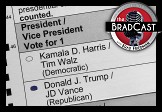 'Bullet Ballot' Claims, Other Arguments for Hand-Counting 2024 Battleground Votes: 'BradCast' 11/19/24
'Bullet Ballot' Claims, Other Arguments for Hand-Counting 2024 Battleground Votes: 'BradCast' 11/19/24 'Green News Report' 11/19/24
'Green News Report' 11/19/24 Trump Already Violating Law (He Signed!) During Transition: 'BradCast' 11/18/24
Trump Already Violating Law (He Signed!) During Transition: 'BradCast' 11/18/24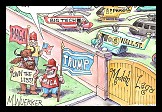 Sunday 'Into the Gaetz of Hell' Toons
Sunday 'Into the Gaetz of Hell' Toons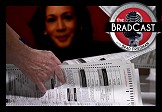 Computer Security Experts Ask Harris to Seek Hand-Counts Due to Voting System Breaches: 'BradCast' 11/14/24
Computer Security Experts Ask Harris to Seek Hand-Counts Due to Voting System Breaches: 'BradCast' 11/14/24  'Green News Report' 11/14/24
'Green News Report' 11/14/24 Trump Criminal Cases Fade After Election as GOP 'Does Not Believe in Rule of Law': 'BradCast' 11/13/24
Trump Criminal Cases Fade After Election as GOP 'Does Not Believe in Rule of Law': 'BradCast' 11/13/24 Climate Advocates Brace for Fight With Trump 2.0: 'BradCast' 11/12/24
Climate Advocates Brace for Fight With Trump 2.0: 'BradCast' 11/12/24 'Green News Report' 11/12/24
'Green News Report' 11/12/24 Let It All Out: 'BradCast' 11/11/24
Let It All Out: 'BradCast' 11/11/24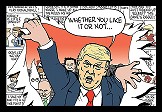 Sunday 'Like it or Not' Toons
Sunday 'Like it or Not' Toons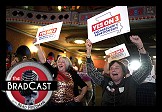 Not All Bad: Abortion Rights Won Big (Almost) Everywhere: 'BradCast' 11/7/24
Not All Bad: Abortion Rights Won Big (Almost) Everywhere: 'BradCast' 11/7/24 'Green News Report' 11/7/24
'Green News Report' 11/7/24 U.S. CHOOSES CONVICTED CRIMINAL, ADJUDICATED RAPIST: 'BradCast' 11/6/24
U.S. CHOOSES CONVICTED CRIMINAL, ADJUDICATED RAPIST: 'BradCast' 11/6/24 ELECTION DAY 2024: Tea Leaves, Probs for Voters, What's Next: 'BradCast' 11/5/24
ELECTION DAY 2024: Tea Leaves, Probs for Voters, What's Next: 'BradCast' 11/5/24 'Closing Arguments' for Undecideds, Third-Party Voters: 'BradCast' 11/4/24
'Closing Arguments' for Undecideds, Third-Party Voters: 'BradCast' 11/4/24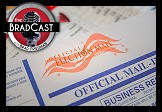 The GOP 'Voter Fraud' Before the Storm: 'BradCast' 10/31/24
The GOP 'Voter Fraud' Before the Storm: 'BradCast' 10/31/24 'Closing Arguments'with Digby and Driftglass: 'BradCast' 10/30/24
'Closing Arguments'with Digby and Driftglass: 'BradCast' 10/30/24 Trump Promises to be a Lawless, Authoritarian President. Believe Him: 'BradCast' 10/29/24
Trump Promises to be a Lawless, Authoritarian President. Believe Him: 'BradCast' 10/29/24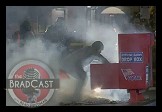 Ballots Burn, Billion-aires 'Obey in Advance', Callers Ring In: 'BradCast' 10/28/24
Ballots Burn, Billion-aires 'Obey in Advance', Callers Ring In: 'BradCast' 10/28/24 Musk's Privatized Internet Satellite System Threatens U.S. National Security
Musk's Privatized Internet Satellite System Threatens U.S. National Security
 VA GOP VOTER REG FRAUDSTER OFF HOOK
VA GOP VOTER REG FRAUDSTER OFF HOOK Criminal GOP Voter Registration Fraud Probe Expanding in VA
Criminal GOP Voter Registration Fraud Probe Expanding in VA DOJ PROBE SOUGHT AFTER VA ARREST
DOJ PROBE SOUGHT AFTER VA ARREST Arrest in VA: GOP Voter Reg Scandal Widens
Arrest in VA: GOP Voter Reg Scandal Widens ALL TOGETHER: ROVE, SPROUL, KOCHS, RNC
ALL TOGETHER: ROVE, SPROUL, KOCHS, RNC LATimes: RNC's 'Fired' Sproul Working for Repubs in 'as Many as 30 States'
LATimes: RNC's 'Fired' Sproul Working for Repubs in 'as Many as 30 States' 'Fired' Sproul Group 'Cloned', Still Working for Republicans in At Least 10 States
'Fired' Sproul Group 'Cloned', Still Working for Republicans in At Least 10 States FINALLY: FOX ON GOP REG FRAUD SCANDAL
FINALLY: FOX ON GOP REG FRAUD SCANDAL COLORADO FOLLOWS FLORIDA WITH GOP CRIMINAL INVESTIGATION
COLORADO FOLLOWS FLORIDA WITH GOP CRIMINAL INVESTIGATION CRIMINAL PROBE LAUNCHED INTO GOP VOTER REGISTRATION FRAUD SCANDAL IN FL
CRIMINAL PROBE LAUNCHED INTO GOP VOTER REGISTRATION FRAUD SCANDAL IN FL Brad Breaks PA Photo ID & GOP Registration Fraud Scandal News on Hartmann TV
Brad Breaks PA Photo ID & GOP Registration Fraud Scandal News on Hartmann TV  CAUGHT ON TAPE: COORDINATED NATIONWIDE GOP VOTER REG SCAM
CAUGHT ON TAPE: COORDINATED NATIONWIDE GOP VOTER REG SCAM CRIMINAL ELECTION FRAUD COMPLAINT FILED AGAINST GOP 'FRAUD' FIRM
CRIMINAL ELECTION FRAUD COMPLAINT FILED AGAINST GOP 'FRAUD' FIRM RICK SCOTT GETS ROLLED IN GOP REGISTRATION FRAUD SCANDAL
RICK SCOTT GETS ROLLED IN GOP REGISTRATION FRAUD SCANDAL VIDEO: Brad Breaks GOP Reg Fraud Scandal on Hartmann TV
VIDEO: Brad Breaks GOP Reg Fraud Scandal on Hartmann TV RNC FIRES NATIONAL VOTER REGISTRATION FIRM FOR FRAUD
RNC FIRES NATIONAL VOTER REGISTRATION FIRM FOR FRAUD EXCLUSIVE: Intvw w/ FL Official Who First Discovered GOP Reg Fraud
EXCLUSIVE: Intvw w/ FL Official Who First Discovered GOP Reg Fraud GOP REGISTRATION FRAUD FOUND IN FL
GOP REGISTRATION FRAUD FOUND IN FL


































